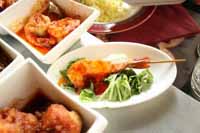Thai food is popular across the world and you’re likely to find a Thai restaurant in every country. But to eat the local food in Thailand itself is a completely different culinary experience.
You will find that harmony is the foundation of each dish and whether it’s a spicy chili laden curry or a more subdued, mild soup, the ingredients are blended together in the most harmonious manner possible. The major tourist centers of Thailand all have authentic Thai restaurants. Exploring the street food culture is another exciting way to get to know the cuisine of the land. Here are five foods every expat must try when living in Thailand.Som Tam (Green papaya salad)
Made from shredded unripe papaya, Som Tam is a spicy salad that is known to be of Lao origin, but still loved and eaten all over Thailand. The characteristic taste of the dish comes from the addition of chili, lime and fish sauce which creates a tantalizing blend of hot, sour and salty flavors. Som Tam may be eaten by itself as a snack with an accompaniment of crisp pork rinds or as part of a meal with other dishes such as fresh rice noodles or sticky rice and fried chicken. Raw vegetables are often served on the side to lessen the spiciness of the salad. The hot and tangy flavor compliments the hot and humid weather of the country very well and the Thai often like their salads extra hot. In Bangkok especially, the local style of Som Tam is quite spicy as a considerable amount of bird’s eye chili is added to the dish. However, it is customary to request that Som Tam be made suited to your tastes.
Khao Soi (Crispy noodles in curry sauce)
Khao Soi, also sometimes spelled khao soy or kao soi, consists of deep-fried crispy egg noodles and meat in a soupy coconut curry sauce, topped with shallots, pickled cabbage and lime. It originated from Myanmar and is commonly eaten in Thailand’s northern cities of Chiang Mai and Chiang Rai. The meat in the dish is usually a chicken leg in many restaurants. Beyond Chiang Mia, Khao Soi has many regional variations. In some variations, the broth is a clear one without the addition of coconut milk, while in some regions blood jelly is added.
Jim Jum (Thai hot pot)
A street variation of the hot spot, Jim Jum is made in a small clay pot and cooked over a charcoal stone. It feeds just two people and is made with broth (either chicken or pork) and fresh herbs like kaffir lime, lemongrass and galangal. Fresh vegetables and seafood may also be added. It is usually served with a spicy dipping sauce. Jim Jum comes from the Thai words ‘jim’ (to dip in) and ‘jum’ (to drop something briefly into liquid). This actually refers to the way in which the dish is eaten wherein a piece of meat is dropped into the simmering broth using chopsticks, moved gently around until cooked and then dipped into the sauce.
Pad Ga Pow Moo Kai Dow (Spicy basil stir-fry)
A very common dish in Thailand, every Thai loves to eat Ga Pow. Made with pork, chicken or seafood and vegetables like green beans, this stir-fried dish is best eaten with some jasmine rice and a fried egg to dim the fiery spiciness. The most essential ingredient in the dish is holy basil, which adds a distinct flavor. It is so popular in Thailand that you can find it in restaurants and as well as dozens of street vendors across the country.
Kao Niew Ma Muang (Mango with sticky rice)
Similar to a rice pudding, Kao Niew Ma Muang is a creamy, sweet treat with a hint of a salty flavor. This traditional Thai desert is eaten in summer when mangoes are in season and it consists of slices of sweet and ripe mango over a bed of glutinous rice. A drizzle of coconut cream syrup is added over the top. It is conventionally made by cooking soaked sticky rice in a steamer until it becomes translucent. Sugar and salt is then added to heated coconut milk, which is poured over the hot rice.

